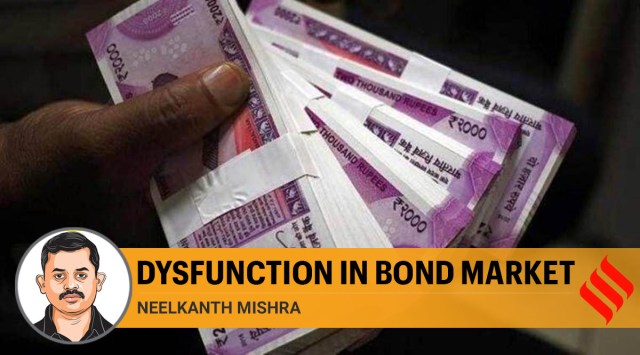- India
- International
New buyers for government bonds needed to bring down borrowing cost
Tapping foreign savings is one step in the right direction, but more needs to be done to make the economy conducive to post-pandemic recovery.
 The RBI sometimes buys bonds to inject money into the economy, but of late this space has been used to buy dollars to save the rupee from appreciation.
The RBI sometimes buys bonds to inject money into the economy, but of late this space has been used to buy dollars to save the rupee from appreciation.Does it even matter what interest rate the government pays on the debt it takes? Interest on government debt is a transfer from taxpayers to savers (who own government bonds), and as the debt outstanding is primarily domestic, it is just a transfer from one hand to the other within the economy. Tax for one is income for the other. Further, unlike private borrowers, who are greatly concerned about their cost of borrowing, decision-makers in governments are not directly affected by the interest rates on offer, and therefore are less worried.
However, the government’s cost of borrowing does matter. The large increase in debt to GDP last year means interest costs as a share of GDP could be 1 per cent point higher than earlier (for state and central governments put together), limiting its ability to spend elsewhere. But more importantly, this rate also affects the cost of borrowing for large parts of the economy. While public discourse focuses overwhelmingly on the rate set by the RBI, two add-ons to that RBI-set rate determine interest rates paid by private borrowers. If these had not risen over the past two years, effective borrowing costs would have been nearly 1 per cent lower than they are now.
The two add-ons are the term premium, and the credit spread. To simplify the jargon, the RBI sets the repo-rate, which is the short-term risk-free rate. That is, the loan must be repaid in a few days and there is almost no risk of default. The rate at which the government borrows is the long-term risk-free rate. It is risk-free as the government can, in the worst case, print money to service its repayments, but the lender wants higher returns given the longer duration of the loan. The difference between the repo rate and government’s borrowing cost, say on a 10-year loan, is called the term premium. When a private firm takes a 10-year loan, it would have some credit risk too, which means a credit spread is added to the 10-year risk-free rate.
Of the two, it is the term premium that poses the bigger challenge, currently, to policymakers. From an average rate of 73 basis points since 2011 (one basis point is one-hundredth of a per cent), and 120 basis points in 2018 and 2019, the 10-year term premium is currently 215 basis points, having risen 35 basis points since the budget presentation, and among the highest in the world.
Financial markets are forward-looking, and as the collective expression of the views of thousands of participants, efficient ones can occasionally “predict” what comes next. But the Indian bond market is not one such: The view some hold, that the rise in term premium reflects future rate hikes by the monetary policy committee (MPC), is mistaken, in our view. The Indian bond market is still too illiquid and not diverse enough to predict future trends. Even though some pandemic-driven measures are being withdrawn, the MPC continues to be accommodative, and for several months at least, headline inflation is unlikely to force an abrupt change. In any case, the spurt in yields after the budget points to the causality being fiscal instead of inflation-related.

But even the fiscal rationale seems weak. Compared to what the bond market was anticipating, the union budget projected higher bond issuance of Rs 80,000 crore in FY2020-21 and Rs 60,000 crore in FY2021-22. Since then, the Centre’s tax collection for FY2020-21 has been substantially ahead of target, and state governments have also borrowed Rs 60,000 crore less than expected. Further, 14 states (accounting for three-fourths of all state deficits) have budgeted FY2021-22 deficits at 3.3 per cent, far lower than the 4 per cent average expected earlier. Just these factors suggest that total bonds issued by the central and state governments should be lower than what the market had feared before February 1, when the union budget was presented. And yet, government borrowing costs have not returned to pre-budget levels.
In our view, this reflects dysfunction in the market. Why else would a government be borrowing at a higher cost than a mortgage on a house? While the latter, understandably, is against a collateral (the house), was the lending to a sovereign not supposed to be risk-free?
The roots of this dysfunction can be traced to residential mortgages being among the most competitive of loan categories, one where even public sector banks are active. On the other hand, there is a structural shortage in demand for government bonds; in such a market, the marginal buyer holds all the cards, and as any buyer would, demands higher returns.
Over 15 years, the share of banks in the ownership of outstanding central government bonds has fallen from 53 per cent to 40 per cent now, as policy has correctly tried to reduce financial repression (that is, forcing banks to deploy the deposits they collect into government bonds). But no alternative buyer of size has emerged to fill the space vacated: Despite improving penetration of insurance and formalisation driving growth in pension inflows, their share of bonds outstanding has in fact shrunk over the last 15 years. The RBI sometimes buys bonds to inject money into the economy, but of late this space has been used to buy dollars to save the rupee from appreciation.
As tinkering with the share of funds that banks, insurance or pension funds must deploy in government bonds may be inappropriate, the solution may lie in getting new types of buyers. The RBI opening up direct purchases by retail investors is a step in this direction, though it may not become meaningful for a few years.
That leaves us with tapping foreign savings. The share of government bonds that foreign portfolio investors (FPIs) can buy has been raised steadily, but without Indian bonds being included in global bond indices, these flows may not be meaningful, and would be volatile, as they have been over the past year. To enable inclusion in bond indices, the RBI and the government have earmarked special-category bonds which are fully accessible (FAR) by foreign investors.
The FTSE putting India on a watch-list for “potential future inclusion” in the Emerging Markets Government Bonds Index as “global index users … (have shown) … interest in Indian government securities issued through the (FAR)” is a step forward, and, one hopes, triggers similar actions by other index providers. However, this process needs to be speeded up. This is not just for the government’s own fiscal space, but also to ensure that the cost of borrowing in the economy is conducive to a post-pandemic recovery.
This column first appeared in the print edition on April 6, 2021 under the title ‘Dysfunction in bond market’. The writer is co-head of APAC Strategy and India Strategist for Credit Suisse
EXPRESS OPINION
More Explained
Apr 25: Latest News
- 01
- 02
- 03
- 04
- 05











































